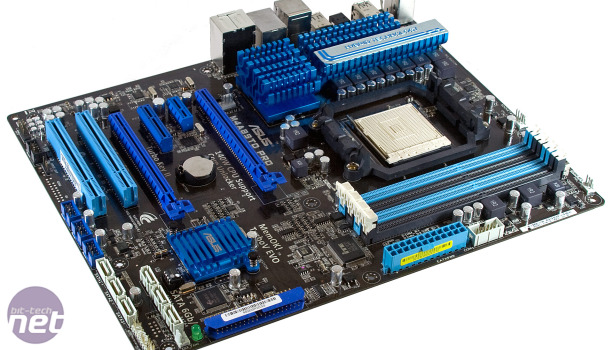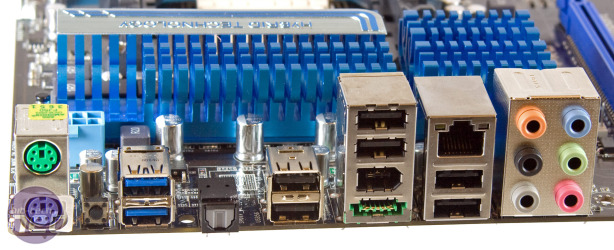Features and Layout
Another irritating point is the memory slots - there's now plenty of space between them and the 16x PCI-Express slots, which is great, but using those single ended connectors was only meant to be for when there was no space. Why use them when they are not needed? The end clips are a benefit for making sure the DIMMs are inserted correctly.Finally, there's the cooling approach. Taking a leaf out of MSI's book, the 890FX chipset is in line with the CPU power hardware and appears to share a single heatsink, however it is in fact two linked by a very short and flat heatpipe. The chipset heatsink is screwed down, but the CPU MOSFET heatsinks and held in place by push-pins. The heatsink is slightly meatier than the MSI 890FX one, which helps, however it's a little too stout around the mid-riff for the large hold-down plate of the Titan Fenrir CPU cooler. It just fits but there's some chaffage. Up the other end and the way Asus has cut out a gap for finger access to the 8-pin EPS12V connector looks ugly to say the least.
These gripes aside, the rest works. The pin-outs are suitably placed around the edges and generally things are easy to get to.
In terms of power hardware, the CPU gets a 4+1 phase, doubled up to 6+2 since no PWM IC is currently available to allow more on AMD chipsets, and this is all controlled by an Asus EPU above the CPU socket. The northbridge and four memory slots both get a power phase and the whole board gets the usual mix of long life caps and 2oz copper PCB.
What we love are the extra little bits Asus has squirrelled into the corners. The MemOK button is an automated control for memory compatibility - OK its use is negligable, but it's a nice to have backup, but more importantly is the Core Unlocker and TurboKey switches above the memory slots. While a little stiff to use, they respectively enable the hidden cores of compatible CPUs and then dynamically overclock them according to CPU load - like bringing Intel's TurboBoost to AMD. Pretty damn inventive.
Rear I/O
Asus M4A89TD Pro rear I/O is very full - eight USB 2 ports make for plenty of potential peripherals, although despite those two blue ones there's no USB 3 here. Firewire, eSATA, S/PDIF out, PS2 keyboard and mouse and Gigabit Ethernet make up the other ports, and there's also the six 3.5mm audio jacks providing the eight channels of audio as well as microphone and line inputs.There's even a tiny clear CMOS button nestled in the cracks, which is great to see, even despite there being no power and reset buttons.

MSI MPG Velox 100R Chassis Review
October 14 2021 | 15:04













Want to comment? Please log in.